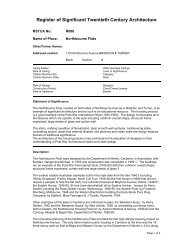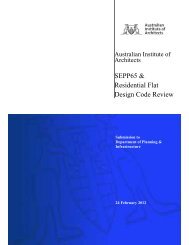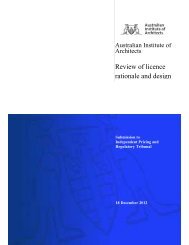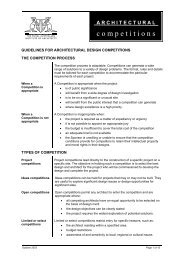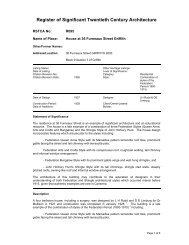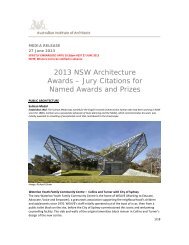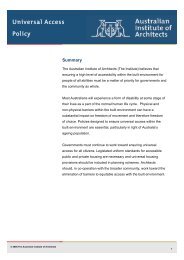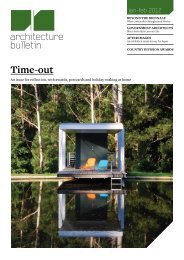Winter - Australian Institute of Architects
Winter - Australian Institute of Architects
Winter - Australian Institute of Architects
- No tags were found...
Create successful ePaper yourself
Turn your PDF publications into a flip-book with our unique Google optimized e-Paper software.
Reviews provided by B<strong>of</strong>fins BookshopBook Reviews806 Hay Street, Pertht: 08 9321 5755e: info@b<strong>of</strong>finsbookshop.com.auwww.b<strong>of</strong>finsbookshop.com.auLiving Streets: Strategies forCrafting Public Space62THE ARCHITECT 2012 ISSUE 002Norman Foster: A Life inArchitectureDeyan SudjicISBN 9780753828571Phoenix, 2012, s<strong>of</strong>tcover$35.00Norman Foster is a phenomenon – as anarchitect, but also as an individual. He isresponsible for a dozen or more <strong>of</strong> the mostrecognisable buildings <strong>of</strong> the last thirty years.Deyan Sudjic explores Foster’s impact onarchitecture and on the contemporary city.He traces his remarkable journey from thebackstreets <strong>of</strong> Manchester, the determinationwith which he has built a global architecturalpractice and his huge creative influence.Amongst many other buildings, Norman Fosteris responsible for the design <strong>of</strong> Beijing’s newairport, one <strong>of</strong> the world’s largest; for the Rossiyatower in Moscow; one <strong>of</strong> the towers at GroundZero; and a crop <strong>of</strong> new towers in London. Healso designed the Reichstag, the new Wembleystadium and the British Museum’s new court.Sudjic’s insightful and elegantly writtenbiography charts the remarkable life <strong>of</strong> one <strong>of</strong> theworld’s most influential architectural figures.Lesley Bain, Barbara Gray and Dave RodgersISBN 9780470903810Wiley, 2012, hardcover$105.00Today, society is moving toward a moresustainable way <strong>of</strong> life, with cities everywhereaspiring to become high quality places to live,work and play. Streets are fundamental to thisshift. They define our system <strong>of</strong> movement,create connections between places, and <strong>of</strong>feropportunities to reconnect to natural systems.Living Streets provides practical guidance onthe complete street approach to sustainableand community-minded street use and design.Written by an interdisciplinary team <strong>of</strong> authors,the book brings insights and experience fromurban planning, transportation planning andcivil engineering perspectives. It includesexamples from many completed street designprojects from around the world, an overview<strong>of</strong> the design and policy tools that have beensuccessful, and guidance to help get past thepredictable obstacles to implementation: Whomakes decisions in the right-<strong>of</strong>-way? Who takesresponsibility? How can regulations be changedto allow better use <strong>of</strong> the right-<strong>of</strong>-way?If you’re an urban planner, designer,transportation engineer or civil engineer, LivingStreets is the ultimate guide for the creation<strong>of</strong> more humane streetscapes that connectneighbourhoods and inspire people.Houses <strong>of</strong> the Sundown Sea:The Architectural Vision <strong>of</strong>Harry GesnerLisa Germany, new photography by Jergen NogaiISBN 9781419700491Abrams, 2012, hardcover$100.00Casual observers and architectural aficionadosalike have for decades strained to catch glimpses<strong>of</strong> Harry Gesner’s spectacular houses. For morethan sixty years, maverick architect and Californianative Harry Gesner has been designing homesinspired by his lifelong muse, the mythicallandscape <strong>of</strong> Southern California – the land <strong>of</strong> thesundown sea.Houses <strong>of</strong> the Sundown Sea is the first book toexamine Gesner’s work, tracing his long life andcareer through fifteen <strong>of</strong> his most intriguing,highly unorthodox, and dramatic houses, whichwere built, for the most part, during the 1950sthrough the 1970s. Throughout his career, Gesnerwas drawn to unusual, challenging sites – thekind that most architects turned down asimpossible to develop – and tapped into a broadstreak <strong>of</strong> invention and innovation that coursesthrough both himself and his houses. Thoughimpossible to categorise, his eccentric housesdisplay signature style characteristics, such ascopious use <strong>of</strong> natural materials, especially woodand Santa Barbara fieldstone; soaring ro<strong>of</strong>lines;circular rooms; and enormous beams that travelacross ceilings, plunge through glass walls, andreach out into the stratosphere.Gesner’s personal archive <strong>of</strong>fered an abundance<strong>of</strong> material – from his own elaborate and detailedrenderings, plans, blueprints and drawings tovintage photography <strong>of</strong> both his private life andmany <strong>of</strong> the featured houses.Juergen Nogai was specially commissioned tophotograph the houses for this book and hisspectacular images depict them in a new light.Lisa Germany’s text captures the essence <strong>of</strong>Gesner as both man and architect. He is stillinventing, still creating, still designing.







